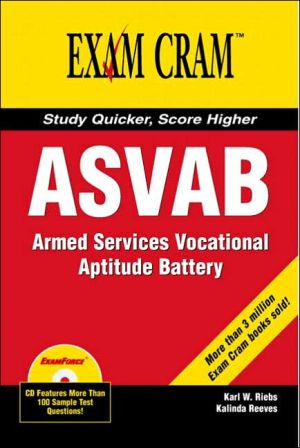ASVAB: Armed Services Vocational Aptitude Battery (Exam Cram)
Students, if you are preparing for the ASVAB exam, get ready for it with the best—ASVAB Exam Cram. Verbal, math, science and technical skill sets are all covered in this succinct review guide. By giving you examples, test-taking advice and tips and a CD with a powerful test engine to practice with, ASVAB Exam Cram will help you perform at the top of your game on test day. Learn what your weaknesses and strengths are quickly as you receive explanations of both correct and incorrect answers on...
Search in google:
Students, if you are preparing for the ASVAB exam, get ready for it with the best—ASVAB Exam Cram. Verbal, math, science and technical skill sets are all covered in this succinct review guide. By giving you examples, test-taking advice and tips and a CD with a powerful test engine to practice with, ASVAB Exam Cram will help you perform at the top of your game on test day. Learn what your weaknesses and strengths are quickly as you receive explanations of both correct and incorrect answers on your practice exams. Deciding to enter the military is serious, as is the ASVAB exam, so study for it with the best.
IntroductionIntroduction\ Welcome to the ASVAB Exam Cram. In the pages of this book you will find tips and essential information you will need to score your absolute best on the Armed Services Vocational Aptitude Battery (ASVAB).\ You might be taking the ASVAB to explore your aptitude for a variety of civilian careers, or to begin the process of enlistment in the armed forces. Either way, you want your performance on the ASVAB to showcase what you already know and demonstrate your readiness to achieve proficiency in the vital skill sets called for by the modern military and civilian workplaces. Simply put, the better you perform on the ASVAB, the greater your career opportunities will be.\ The goal of the ASVAB is straightforward. It is not designed to trip you up or screen you out. It is basically a tool you can use to introduce yourself to your prospective employer and take control of your own future.\ Much like military service itself, success on the ASVAB requires disciplined, targeted preparation. A soldier heading into battle carries only the essential equipment for survival in the field and victory in combat. Your ASVAB Exam Cram preparation is your "combat gear" for an assault on the ASVAB. Our goal is not to try to teach you all the material you need to know about every topic. Instead, we will provide you with focused review materials and key tactical insights for overcoming potential problem areas. We leave out all the fluff to keep your pack light and all your energies focused on the objective.\ Let's get started!Taking the ASVAB\ The ASVAB is administered by the Department of Defense (DoD) and is free of charge. It comesin several forms; however, the tests themselves (and the preparation techniques required) are not all that different. The ASVAB tests are as follows:\ \ \ ASVAB 18/19—Administered in over half of all U.S. high schools as part of the "Career Exploration Program," this version is used as a tool for students and guidance counselors to assess career aptitude (both civilian and military). This test comes in a paper version and consists of eight sections. See your guidance counselor for more information, or visit http://www. asvabprogram.com.\ \ \ Paper Version ASVAB—Administered by recruiters for use in direct enlistment into the armed forces it contains eight subject area sections (see Table 0.1 below) and may also contain a ninth section called "Assembling Objects." Contact a recruiter from the service branch of your choice to schedule the test.\ \ \ CAT ASVAB—The Computer Adaptive Test (CAT) is also administered by recruiters for use in direct enlistment into the armed forces. This version is becoming more common, is given only at Military Entrance Processing Stations (MEPS), and, in some areas, may be the only version available. The main difference between the CAT and paper version is that the CAT adapts (or adjusts on the fly) to determine your level of ability. The better you do on the early questions, the higher the level of difficulty you can reach, and the higher you can score. The downside is that you don't have the option to skip over and return later to a tough question that has you bogged down. The CAT ASVAB contains nine or ten sections ("Shop" and "Auto Information" sections may be separated), including the "Assembling Objects" section. Contact a recruiter from the service branch of your choice to schedule the test.\ \ \ \ Caution - If you are taking the ASVAB through a recruiter, he or she may accompany you to the test site and wait for you to complete the test. You may even be offered a ride to and from the test location. Do not allow yourself to feel pressured to hurry through the test so that you don't inconvenience the recruiter. They are just doing their job. Yours is to focus on the test and do your best.\ \ When you add up the time required for each section of the test (see Table 1) and throw in extra time for administration, the ASVAB takes about three hours to complete. In between sections of the CAT-ASVAB, you may take a short break before moving on. If you take longer than two minutes before advancing to the next screen, your computer terminal will lock up on you. This will require the proctor to come to your terminal and key in the password to resume testing. There is no penalty for locking up your terminal in this way, but it can be distracting to the other test takers.Table 1 ASVAB Test Sections\ \ \ \ \ \ \ \ \ \ Order\ \ \ Section\ \ \ Number of Questions\ \ \ Time Allowed\ \ \ \ \ 1\ \ \ General Science\ \ \ 25\ \ \ 11 minutes\ \ \ \ \ 2\ \ \ Arithmetic Reasoning\ \ \ 30\ \ \ 36 minutes\ \ \ \ \ 3\ \ \ Word Knowledge\ \ \ 35\ \ \ 11 minutes\ \ \ \ \ 4\ \ \ Paragraph Comprehension\ \ \ 15\ \ \ 13 minutes\ \ \ \ \ 5\ \ \ Mathematics Knowledge\ \ \ 25\ \ \ 24 minutes\ \ \ \ \ 6\ \ \ Electronics Information\ \ \ 20\ \ \ 9 minutes\ \ \ \ \ 7\ \ \ Mechanical Comprehension\ \ \ 25\ \ \ 19 minutes\ \ \ \ \ 8\ \ \ Shop and Automotive Information\ \ \ 25\ \ \ 11 minutes\ \ \ \ \ 9\ \ \ Assembling Objects\ \ \ 16\ \ \ 9 minutes\ \ \ \ \ Taking the ASVAB in no way obligates you to join the military, but it is an excellent way to begin a conversation with a recruiter to help you gather information about possible career fields and job opportunities that might be open for you. You also can use the Internet to research military occupations. Each branch of the armed forces has its own website, as listed here:\ \ \ Army—http://www.army.mil\ \ \ Air Force—http://www.af.mil\ \ \ Navy—http://www.navy.mil\ \ \ Marine Corps—http://www.usmc.mil\ \ \ Coast Guard—http://www.uscg.mil\ \ \ As an alternative, you can visit http://www.careersinthemilitary.com or http://www.military.com to get an overview of each branch.Arriving at the Exam Site\ After you have studied the material, taken the practice tests, and reviewed your weak areas, you are academically ready to take the ASVAB. But your preparation doesn't end there. To ensure your readiness you need to be well rested, on time (which, as for any professional appointment, means that you should arrive 1015 minutes early) and comfortably, but appropriately dressed. Essentially this means that you should wear casual, but professional, clothes and shoes. Don't waste the recruiter's time by missing or being late to your appointment and don't waste your time by pulling an all-nighter before the test that prevents you from being at your sharpest. Along with being well rested, make sure you have eaten a good meal before test time; you'll need your energy. Once the test starts, the proctor may excuse you momentarily to use the restroom, however, it is best to take care of that need before the test begins. Here's what you'll need to take with you to the test site:\ \ \ A picture ID (such as driver's license)\ \ \ A completed Form 680 (the equivalent of an admissions ticket, your recruiter will have this form and help you fill it out)\ \ \ Scratch paper and pencils will be provided at the test site In the Exam Room\ Chances are good that you will not be the only test-taker in the exam room on the day of your ASVAB. Whether there are only a few or as many as 20 others, remember that everyone works at his or her own pace. Just because someone else may zoom through the test and finish ahead of you, doesn't mean that you are falling behind or need to pick up the pace. Work at your own pace, being mindful of the time limits for each test section, in the same way that you practiced when working through the sample tests in this book.\ The test environment will be professional and quiet. There will be a proctor to help you with any questions, provide you with extra pencils and scratch paper if you need, and to unlock your computer terminal if you take too long to answer a question or read the sample question instructions; both situations will cause your screen to "lock up," thus preventing you from proceeding without assistance.\ Answer sheets for the paper version of the ASVAB resemble any other standardized testing form. You must completely and neatly fill in the bubble corresponding to your answer choice. The CAT ASVAB instructions and questions appear in white lettering on a blue screen background. You may also have a specially labeled keyboard on which you can only select from the keys A, B, C, D, E, Enter, Spacebar, or HELP. Don't skip over the instructions. Read them carefully and follow them throughout the test.\ When you complete each section of the test you will be notified on screen and then can move on to the instructions and examples for the next section. At the end of all sections, you will be expected to check out with the proctor and to turn in your pencils and all scratch paper (used and blank). Nothing leaves the testing room. For the CAT ASVAB your recruiter will likely be able to give you your score the next day.Study and Exam Preparation\ Regardless of the testing format you are taking, the old saying that "practice makes perfect" applies. The more effort you put into reviewing and practicing (under test-like conditions) the type of questions you'll be facing, the better you will do.About This Book\ Each Exam Cram chapter follows a regular structure and contains graphical cues about important or useful information. Here is the structure of a typical chapter, including special features that may be used to highlight key points:\ \ \ Opening Hotlists—Found on the first page of each chapter, these lists highlight terms, concepts, and information you will need to become familiar with throughout the chapter.\ \ \ Topical Coverage—The heart of the chapter, this is a summary of the subject matter vital to success on that subject area of the exam.\ \ \ Notes and Tips—These are useful pieces of information, shortcuts, or more efficient ways to tackle a type of exam question.\ \ \ Exam Alerts—Here is your "heads up" for items you can be certain will show up on the exam.\ \ \ Exam Prep Practice Questions—Each chapter contains a set of 1015 practice questions to help you solidify your understanding of the material covered. The correct answer is given along with an explanation of why it is correct and why the other choices are not. Use these questions to pick out weak areas you should review before taking the Sample Exams at the back of the book.\ \ \ Need to Know More?—Found only on the CD-ROM, this is a listing of other sources of information to hone your skills in a particular way.\ \ \ Using This Book\ You may use this book according to your own needs. Everyone should begin with the Self Assessment to gauge his or her particular strengths and weaknesses and to get a feel for the ASVAB. Treat all practice exams as though they were the real thing. Find a quiet place, use a timer, and don't allow yourself to be interrupted until the time is up.\ After you've completed the Self Assessment, review your personal objectives in taking the ASVAB. Everyone should focus effort on preparing for the four sections that comprise the Armed Forces Qualification Test (AFQT). You must achieve a minimum score on the AFQT for the different branches of the service. The sections that make up the AFQT are: Word Knowledge, Paragraph Comprehension, Arithmetic Reasoning, and Mathematics Knowledge.\ If you find yourself short of time before your ASVAB test date, study the areas of weakness identified in your Self Assessment and be sure to at least skim every chapter to absorb the Tips, Exam Alerts, and Cautions.\ Ideally, you will take the time to move steadily through each chapter, taking note of areas in which you need to do additional study. This will prepare you to take the Practice Exams found at the end of the book. Treat this book like a study outline and don't hesitate to mark it up, highlight key information, and fold down the corners of important pages for future reference. Also note that at the very end of this book are answer sheets you can use for your practice exams.\ We hope you enjoy using this Exam Cram book and that as a result of your focused preparation you will be well on your way toward a rewarding career.\ \ © Copyright Pearson Education. All rights reserved.
Introduction. Self-Assessment. Chapter 1: General Science. Physical Sciences Scientific Method: Observation and Measurement Chemistry Physics Life Sciences Biology Human Anatomy and Physiology Ecology Earth and Space Sciences Geology Meteorology Astronomy Exam Prep Questions Exam Prep Answers Chapter 2: Arithmetic Reasoning. Arithmetic: A Review Arithmetic Operations Fractions Decimals Putting Fractions and Decimals to Use on the ASVAB Reasoning: Using Arithmetic to Solve Your Problems Word Problems Series Exam Prep Questions Exam Prep Answers Chapter 3: Word Knowledge. Building Your Vocabulary Understanding Context Experience Clues Definition or Paraphrase Clues Example Clues Comparison and Contrast Clues Synonyms and Homonyms Words and Their Synonyms Using a Thesaurus Confusing Homonyms Understanding Denotation and Connotation Denotation Connotation Finding Word Meaning Through Structure Root Words Prefixes Suffixes Exam Prep Questions Exam Prep Answers Chapter 4: Paragraph Comprehension. Reading for Details Reading for Comprehension Subject Matter Main Character Setting Point of View Action and Plot Grouping Sequences Reading for Content, Comprehension, and Context Readingfor Content–The Literal Level Reading for Context–The Interpretive Level Reading at the Applied Level Developing a Summary Improving Your Reading Abilities Improving Your Comprehension Improving Your Reading Speed Tips for Increasing Your Reading Rate Adjusting Your Reading Rate Tips for Success on the Reading Comprehension Battery Exam Prep Questions Exam Prep Answers Chapter 5: Mathematics Knowledge. Taking the Mathematics Knowledge Test More Fun with Numbers Factors and Multiples The Factorial (!) Exponents and Roots Operations with Negative Numbers Order of Operations Algebra Algebraic Equations Performing Operations with Algebraic Expressions Factoring Algebraic Expressions Inequalities Geometry Lines Angles Triangles Quadrilaterals Circles Volume Exam Prep Questions Exam Prep Answers Chapter 6: Electronics Information. Schematics Principles of Electricity Current Electromotive Force and Voltage Resistance and Impedance Ohm’s Law Power Electrical Components and Properties Batteries Wiring Resistors Transistors Conductors and Conductivity Capacitors, Capacitance, and Capacitive Reactance Switches Insulators Magnets and Electromagnets Inductors, Inductance, and Inductive Reactance Transformers Rectifiers and Inverters Electrical Safety Discharging a Capacitor Electrical Fires Exam Prep Questions Exam Prep Answers Chapter 7: Mechanical Comprehension. Mechanical Principles Work and Mechanical Energy Mechanical Advantage Friction Calculating Efficiency Principle of Moments and Torque Mechanical Motion Forces of Motion Motion and Mechanical Laws Simple and Compound Machines Levers Wheel and Axle Pulleys Inclined Planes Wedges Screws Gears and Other Simple Machines Structural Support Structure Types Load Types Mechanical and Structural Properties Stress Strain Modulus of Elasticity Properties of Materials Metals Ceramics Organics Synthetics and Polymers Fluid Dynamics Specific Gravity Pressure Archimedes and Fluid Displacement Bernoulli and Fluid Movement Exam Prep Questions Exam Prep Answers Chapter 8: Shop Information. Tools Measuring Tools Cutting and Shaping Tools Drilling Tools Fastening Tools and Fasteners Shop Processes Welding Soldering Brazing Machining Shop Project Planning Exam Prep Questions Exam Prep Answers Chapter 9: Automotive Information. A Look Under the Hood A Word on Safety Tools of the Trade Hand Tools Power Tools Cleaning Equipment Metalworking Tools Measuring Systems and Tools Fasteners Engine Classifications Combustion Types Cylinder Number and Arrangement Valve Arrangement Cycling Combustion Chamber Shape Engine Types Rotary Engine Piston Engines Engine Systems Lubrication System Cooling System Fuel System The Drive Train Manual Transmissions Automatic Transaxle and Transmission Drive Line Arrangements Drive Train Components Electrical Systems Charging System Battery Starting System Ignition System Ignition Classifications Lighting and Accessory System The Chassis Systems Tires and Wheels Emission Systems Exam Prep Questions Exam Prep Answers Chapter 10: Assembling Objects. Puzzle Piece Assembly Labeled Part Connections Exam Prep Questions Exam Prep Answers Chapter 11: Practice Exam 1. Word Knowledge Paragraph Comprehension Electronics Information Automotive Information Mechanical Comprehension Chapter 12: Answers to Practice Test 1. Word Knowledge Paragraph Comprehension Electronics Information Automotive Information Mechanical Comprehension Chapter 13: Practice Exam 2. General Science Arithmetic Reasoning Mathematics Knowledge Shop Information Assembling Objects Chapter 14: Answers to Practice Exam 2. Answers to General Science Answer Explanations for General Science Answers to Arithmetic Reasoning Answer Explanations for Arithmetic Reasoning Answers to Mathematics Knowledge Answer Explanations for Mathematics Knowledge Answers to Shop Information Answer Explanations for Shop Information Answers to Assembling Objects Answer Explanations for Assembling Objects Appendix A: CD Contents and Installation Instructions. The CramMaster Engine Multiple Test Modes Pretest Mode Adaptive Drill Mode Simulated Exam Mode Istalling CramMaster for the ASVAB Exam Using CramMaster for the ASVAB Exam Customer Support Appendix B: Need to Know More? - 403 (on the CD). Glossary. Index.








